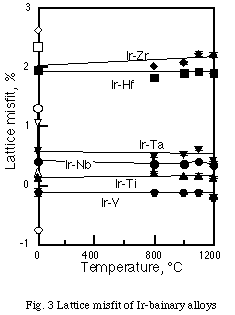Development of Ir-base refractory superalloys
Y. Yamabe-Mitarai, Y. Koizumi, Y. Ro, T. Yokokawa, T. Maruko, and H. Harada
The compression strengths of Ir-15at%X (X= Ti, Ta, Nb, Hf, Zr,
or V) binary alloys at temperatures between room temperature and 1800
�$B%$�(B were investigated. 0.2% flow stresses of as-cast alloys are shown
in Fig. 1. The 0.2% flow stresses of a Ni-Al-Cr alloy with 40%
L12 phase(1), a commercially available Ni-base superalloy,
MarM247 (Ni-10Co-10W-8.5Cr-5.5Al-0.7Mo-3Ta-1.4Hf wt%)(2), and the
tensile yield stresses of a third generation single crystal Ni-base
superalloy, CMSX-10
(Ni-2Cr-3Co-0.4Mo-5W-8Ta-6Re-0.1Nb-5.7Al-0.2Ti-0.03Hf wt%)(3) and of a
W-base HfC dispersion hardening alloy (W-0.35wt%Hf-0.025wt%C)(2) are
also plotted for reference. The strengths of the Ir-Nb, Ir-Ta, Ir-Hf,
and Ir-Zr alloys were equivalent to or far higher than the strengths
of MarM247 and CMSX-10 below 1000 C. The 0.2% flow stress of these 4
Ir-base alloys were above 800 MPa even at 1200 �$B%$�(B and much higher than
that of MarM247 (50 MPa) at that temperature. At 1800 �$B%$�(B, the
strengths of the 4 Ir-base alloys were about 200 MPa and they are
equivalent to the strength of the W-HfC alloy (197 MPa), which had
been the strongest known metallic material available at this
temperature. The strengths of the Ir-Ti and Ir-V alloys were low at
all testing temperatures.
The 0.2% flow stresses of the as-cast Ir-17at% Ti, Ir-18at% Ta,
Ir-17at% Nb, and Ir-12at% Zr alloys with 50% volume fraction of
precipitates were investigated by compression testing at 1200 �$B%$�(B (Fig.
2) as a function of lattice misfit determined by high temperature
X-ray diffractometry (Fig. 3). The strength of these Ir-base alloys
increased with increasing lattice misfit.
The fcc and
L12 two phase structures of these alloys heat treated at
1200 C for 1 week were observed by transmission electron microscopy
(Fig. 4). The
phases with bright contrast were Ir3V, Ir3Ti,
Ir3Nb, and Ir3Zr with the L12
structure. Precipitates shape depends on lattice misfit between the
fcc matrix and L12 precipitates. When lattice misfit is
smaller than 0.2%, precipitate shape is irregular (Ir-V and
Ir-Ti). When lattice misfit is moderate around 0.3%, cuboidal
precipitates are formed (Ir-Nb and Ir-Ta). In the Ir-Hf and Ir-Zr with
large lattice misfit above 1.8%, plate-like precipitates are formed
and the microstructure appeared to have a 3 dimensional maze
structure.
It was concluded that the 3 dimension maze
structure prevent movement of dislocations and is effective for high
temperature strength.





